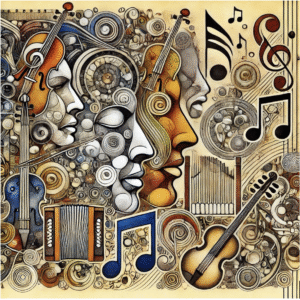
Babu’s voice echoed in the training room. Chingalaka Ching, Boomlaka Boom… It started with a slow beat, gradually building in pace and varying in pitch. All the participants in the “Art and Media-based Peacebuilding” course followed him, but each with their own creative expression: Boomlaka Boom… Chingalaka Ching… Boomlaka Boom… Within minutes, the atmosphere in the room transformed. Every corner was filled with laughter, rhythm, joy, a sense of belonging, energy, love, and freedom. What a magical verse, Chingalaka Ching. It touched our hearts and souls. I hurried over to Babu, my curiosity sparked. “Babu,” I asked, my voice tinged with wonder, “What magic do the words ‘Chingalaka Ching’ hold?”
Babu laughed and replied, “Nothing. Actually, it has no meaning.”
What? I was surprised.
But the question lingered in my mind, so I decided to ask the participants who were singing ‘Chingalaka Ching’ with such joy and what it meant to them. The group was diverse, coming from different countries, religions, and schools of thought.
“What does Chingalaka Ching mean to you?”
“If I translate it into Spanish, it means joy, energy, and fun,” said Delia from Guatemala, her eyes shining. Daryl Snider, a musician and calm participant, smiled and said, “I love how Chingalaka Ching draws us all into a simple community activity where we can be joyful together.” Raffi, the most jubilant person in class, felt that Chingalaka Ching represented “energy, unity, and community.” Francis Miller, who plays various musical instruments and understands rhythm and beats, explained, “It’s so simple and not threatening—like child’s play—but it engages everyone.”
Nisrin Ajab, a media professional from Lebanon, created her own meaning, saying, “It’s our identity. It brought us together as one team. I love it, and I love the team.” Rowan, who works in Egypt and feels more comfortable with research and paperwork than art and theatre, had an interesting perspective: “I really enjoy watching Chingalaka Chingand how people respond to it. It helps people move past self-consciousness and participate as part of a whole, rather than just as individuals.”
Gena, a teacher from Nicaragua who loves dancing, had a different take: “I’ll take Chingalaka Ching with me when I go home. I know the children in my class will love dancing to it.” Jonathan, who works in Cambodia, offered a more comprehensive reflection: “It makes me feel like part of something bigger than myself. It gives me a safe space for expressing and releasing a range of emotions, both positive and negative and fills me with satisfaction. It elevates me to another level. It’s a ritual with multiple meanings that change each time I sing it.”
Yes! Jonathan, you’re right. Chingalaka Ching provides a safe space for expressing and releasing a range of emotions, both positive and negative, and fills us with satisfaction. This is what Paulo Freire referred to as the “theory of conscientization.” Chingalaka Ching fosters dialogue and praxis (Action and Reflection), with the key value being “freedom.” Freire aimed to liberate the oppressed. He argued that, “[T]his is the banking system of education, where the scope of action allowed to students is limited to receiving, filing, and storing information… Apart from inquiry, apart from praxis, men cannot be truly human” (Freire, 1972, p.45).
A major critique of Freire’s work is his theory of conscientization itself. Berger argues, “Whose consciousness is supposed to be raised, and who is supposed to do the raising? It may be said that ‘consciousness raising’ is a project of higher-class individuals directed at a lower-class population” (1974, p.2). Furthermore, Rahnema points out that “The oppressed have no power in the first place, and an outsider (the Freirean educator) possesses the secret formula of power to which they must be initiated” (1992, p.123). However, Chingalaka Ching challenges this critique. Here, the Freirean Educator (Babu) arrived with no meanings attached to Chingalaka Ching, and the participants of the Art and Media-based Peacebuilding course created a multitude of meanings through praxis.
Thank you, Babu! Your creative approach made this experience unforgettable.
Yes! You turned something “meaningless” into something deeply “meaningful” for us